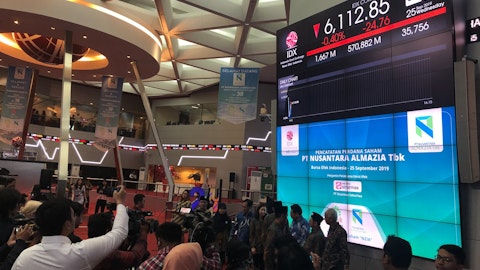Philip Witherington: This is Phil. I’ll make a start and then hand over to Steve with respect to the basis change. And I think what you’re getting at is the very strong contribution to core earnings. Colin referenced this in his remarks. We’ve seen a 33% growth in core earnings in Asia in the quarter. That’s 13% sequentially. And one component of the growth there was the impact of changes in actuarial methods and assumptions. But I think it’s really important to put that into context that off the 33 percentage points of growth, it was about 7 percentage points of growth that was coming from basis change items. The remainder of the growth was coming from commercial factors. And I think what we see in the third quarter is a very good foundation to project from for the future.
And when you reflect on our year-to-date core earnings growth for Asia, that’s been 10%. And I do think there is upside to that 10% rate of growth from factors, such as the opportunity for stronger productivity in our agency channel, as well as the continued emergence of the MCV channel post pandemic. I think there are, of course, always headwinds. We’ve talked about the ongoing challenges that the industry has seen in Vietnam. We’ve seen new regulations coming from the regulator in China, which we expect to impact short term banker momentum. But overall, I do feel positive about the sustainability, not just of Q3, but also growth from there. Steve, did you want to touch on the basis change factors?
Steven Finch: What we’re seeing in Asia from the assumption review falls in that bucket that we call other methods and assumptions. And what this primarily relates to is under IFRS 17, we’ve been refining some of our models, and in particular, the cost of guarantee calculation on par, which is a new requirement under IFRS 17. So, through the year, we actually changed how we manage the business in terms of how we pass experience back through dividends to customers. We updated the models. We reflected higher interest rates. And that resulted in a net release of liabilities, a large portion of which is coming through the CSM. So as Phil noted, the basis change is impacting positively the Asia earnings through a higher CSM balance and slightly faster amortization of CSM that was more mechanical as opposed to anything that we did on the amortization.
Darko Mihelic: Steve, just to follow up on that. So the faster amortization of CSM is a permanent thing or did it just affect this quarter?
Steven Finch: No, that would be an ongoing run rate.
Operator: The next question is from Nigel D’Souza from Veritas Investment Research.
Nigel D’Souza: I wanted to dig into the actuarial review this quarter. And I noticed that when it comes to experience, the experience since COVID-19 pandemic, I believe, was excluded from the review. I’m just trying to get a sense of how you determined which experiences in 2020 was an outlier versus what could be more indicative of post-COVID experience and how that factored into the review this quarter.
Steven Finch: It’s Steve. So how we dealt with COVID in the review is, for long term insurance products, where we felt that that the experience during COVID was not indicative of what long term trends would be. we excluded that experience. And that’s consistent with industry practice. And I’ll just point to a comment that I made on one of the earlier questions. For instance, in Canada, the level COI lapse study that we did, we did not include the COVID experience there. But as I noted, experiences already trended back towards the pre-pandemic levels. Where we did reflect more recent experience was on certain morbidity assumptions, where we believe that the experience more recently is indicative of future trends. And that actually strengthened reserves on the morbidity side in Vietnam and was partially offset in Japan. So that’s the approach that we took. And as I noted, it’s consistent with industry standards as well.
Nigel D’Souza: Any comments on mortality? You covered lapse and morbidity, but any thoughts on the mortality experience since 2020?
Steven Finch: So, the review that we did in US life, we updated mortality assumptions. That was based on our own experience before the pandemic, as well as an additional industry study. I would remind you that – it was a modest change in my view, in total. I would remind you that we have a really diversified book of business when it comes to longevity versus mortality. And we saw that through the pandemic, with higher claims in life insurance, fully offset by gains in long term care and annuities from the mortality trends. So just a reminder that we’re well matched on mortality overall.
Nigel D’Souza: Just last question on this, any color you have on – if there were some of the trends that end up being a bit more persistent, maybe not indicative of future trends, but just a change – maybe a slight adverse or favorable change from pre-COVID trends, any sense of what the net impact might have been or could be? Just to gauge what the sensitivity would be to some of these COVID trends.
Steven Finch: As I noted, the mortality trends, we’ve got good offsets. The lapse experience is generally trending back towards pre-pandemic levels. So I’m not going to quote a number. We do provide some sensitivities in the MD&A on our liability assumptions. And as you know, we regularly and routinely update based on emerging experience and our view of the future. So we’ll continue to do that and be transparent about what judgments that we’re making.
Operator: The next question is from Mario Mendonca from TD Securities.
Mario Mendonca: Quickly, first on wealth management. I, obviously, among other things, focus on the operating leverage in that segment. And while it’s been improving, it’s also been negative now for some time because expense growth has been so high. It’s not the top line, the top line looks pretty solid. So could you speak to what these expenses are? And is there a period when we’d expect expense growth to return to something more sort of normal in the mid-single digits?
Paul Lorentz: It’s Paul here. Just on the overall margin, just relative to last year, just a couple of things that we mentioned on last quarter’s call that are just impacting the year-over-year. One is just a reduction in repatriation of seed capital in some private assets that brought down the core earnings. And then the step up acquisition of our China JV, Manulife Fund Management also had an impact overall on the margin year-over-year. The third impact was expense growth, as you noted. Coming into COVID, we did see an increase in expense growth to support the growth of our business, but we recognized that in Q1 of this year, and just looking at the uncertain markets, started taking actions then internally here. And you’ve seen that come through the expense growth since then.
It was down from Q2 to Q1 and Q3 was pretty flat with Q2. What I will say is that expense growth is a continued focus for us in the business. That’s something that we’re looking at how do we get leverage out of the global franchise, and more importantly, you’ve heard Roy talk about our digital ambition and the investments we’re making there. And we expect that to pay dividends for us. So we are expecting to have more muted expense growth go forward for our business based on those efficiencies that we see. And then just looking forward from a margin perspective, we can’t control markets, obviously. And that drives a lot of our fee income. But if you look at some of the other metrics, the top line, as you mentioned, has been very strong, $5.3 billion year-to-date, 12 out of 13 years.




